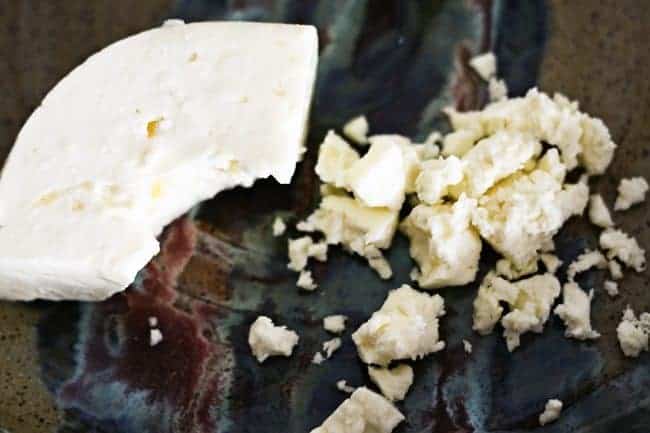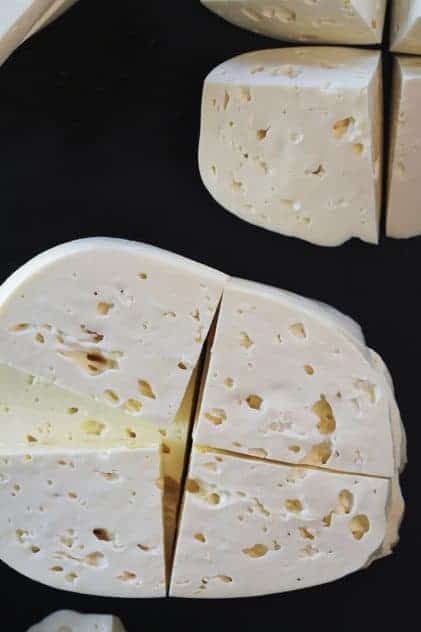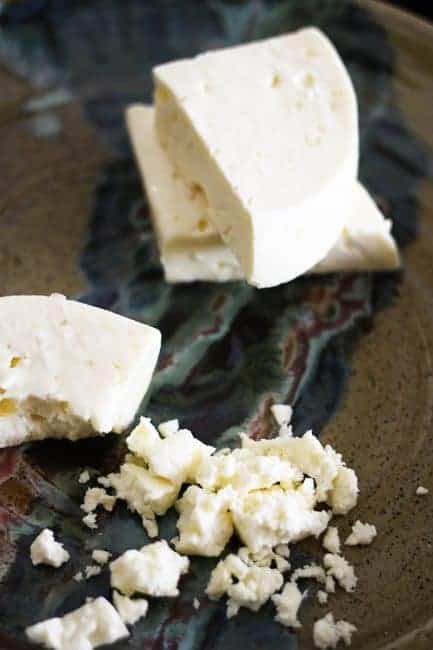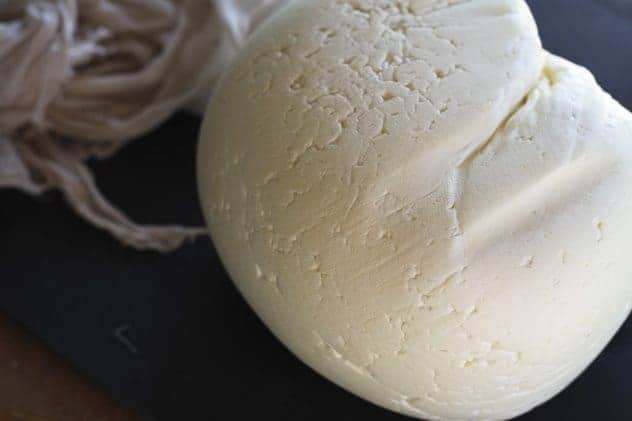I have been promising to bring you my homemade feta cheese recipe for a while (Ahem, probably a couple of years. Eek.) Today is finally the day. You may be wondering why I bother making feta cheese from scratch. The answer-as is often the case- is that homemade tastes great and because I can. I am, after all, the daughter of a man who feels driven to walk laps around the house outside in blizzards when authorities warn that you shouldn’t go out unless you have to do so.
There’s an enormous satisfaction in doing something that seems just undo-able, isn’t there? Not only does homemade feta taste incredible, but it delivers a pioneer, up-by-my-bootstraps joy that a store-bought version just can’t give no matter how wonderful it is.
…But there’s another reason to take the plunge and it’s a doozy. For the cost of three gallons of milk (it can be pasteurized/homogenized or raw, cow or goat milk) and about a dollars worth of other stuff, you get a massive amount of feta cheese. As in a gallon jar of brined feta cheese. If you’re fearful of trying your hand at cheese making, just think of it this way; the risk is about twelve dollars worth of materials (depending on milk cost near you) versus a potential payoff of about forty dollars worth of cheese and an enormous ego boost. If it -bumbum BUM!!!!!- goes wrong, you can feed the errant cheese to dogs, cats, pigs, etc… They’ll be happy.
I’m going to get right into it because even if I’m being succinct, this post is going to be long on account of the how-to photos… There’s no getting around it. Some important notes:
- Stay calm! Cheesemaking is not supposed to be stressful. It may seem complicated, but it isn’t. Just go one step at a time and you’ll get there.
- Don’t get freaked out by the length of time it takes to make this. Much of the time is hands-off time. Another warning for those who haven’t made cheese or fermented something before; it gets a little, um, pungent smelling at times. Keep a-going. Don’t worry! Remember that cheese making is essentially controlling how fast and in what way milk ‘goes bad’. If it goes bad the right way it’s delicious!
- The only special equipment you really need to pull this off is a large stainless steel or other non-reactive pot, a heat source, a long knife or off-set spatula, a colander, something from whence to hang the cheese and butter muslin (extra, super, mega fine cheesecloth.) Do not confuse this with the “fine” cheesecloth you get in the grocery store or hardware store. It’s confusing terminology, but that stuff is so not fine. Just look for something called butter muslin and you’ll be fine. Finer than cheesecloth. Sorry. You can get it here.
- You can opt to use raw OR pasteurized/homogenized milk. It can be cow milk or goat milk. Any of those choices will be delicious.
- Goat milk is naturally more tangy, so if you use cow milk, you may want to consider adding a bit of lipase powder. Lipase is an enzyme that naturally occurs in higher amounts in goat milk. If you want cow milk feta to have that bite that is found in feta, lipase powder is your answer. You can get it via my beloved Amazon.com should you wish to.
- As far as specialty ingredients go, the lipase is optional, but rennet and mesophilic culture are not optional. Again? You can turn to Amazon.com. Here’s one for mesophilic culture.
- Whatever you do, don’t think Junket Rennet will do the job. It simply won’t. That’s for custard making. My preferred cheesemaking rennet is made from animal sources.
- But there is a perfectly acceptable and delicious vegetarian option…
- Finally, I suggest you start the process around lunch time. This gives you the time needed to do the Day One portion of the recipe before too late in the day.
Just think what you’d do with a gallon jar full of fabulous feta cheese. You can go nuts with feta! On pizzas, spanakopita, this tempting salad from my friend, a baked potato, in soup, in omelets, with olives and bread, IN bread, and in just about any recipe that calls for cheese. Where would you use your wealth of feta?

Homemade Feta Cheese | Make Ahead Mondays
Rate RecipeIngredients
For the Cheese:
- 3 gallons fresh raw or pasteurized and homogenized goat or cow milk
- 1/4 teaspoon Mesophilic culture see link in post for source
- 1/4 teaspoon lipase powder if using cow milk Omit for vegetarian cheese. Lipase is animal derived.
- 1 teaspoon single-strength liquid rennet dissolved in 1/2 cup of cool or 1/2 teaspoon double strength liquid OR 3/4 of a vegetarian rennet tablet crushed, UNCHLORINATED water.
- kosher salt no substitute
For the Brine:
- 1/2 cup kosher salt no substitute
- 1 gallon cool UNCHLORINATED water
Instructions
To Make the Cheese:
- Sterilize all of your equipment with boiling water before beginning (including the cheesecloth.)
- In a very large, non-reactive pot, bring all of the milk up to 86°F.-88°F. Add the mesophilic culture and the lipase powder, if you are using it. Stir well with an up and down motion, cover the pot and let rest for one hour. Try to maintain the 86°F temperature. If you have trouble with that, you can set your large pot inside a larger pot with an inch of hot water in the bottom of it. This should help regulate the temperature more gently than firing up a burner directly beneath the milk. The goal is to avoid rapid temperature changes.*See notes.
- After 1 hour, add the dissolved rennet to the milk and stir vigorously for 15-20 seconds. Remove the spoon from the pot, cover it, and let it stand undisturbed for 30-40 minutes or until the curd 'breaks' cleanly when you insert the tip of a knife and lift as shown below.
[img src="https://www.foodiewithfamily.com/wp-content/uploads/2013/01/homemade-feta3.jpg"] - Cut a 1/2-inch grid pattern into the curd. Don't get perfectionist here, you'll get frustrated. The curd likes to move while you try to cut it, so just do your best.
[img src="https://www.foodiewithfamily.com/wp-content/uploads/2013/01/homemade-feta.jpg"] - After you have the grid pattern, hold the knife at a 45° angle and retrace the cuts you've already made. This is going to make MOST of the curd in the pot into roughly 1/2-inch pieces.
[img src="https://www.foodiewithfamily.com/wp-content/uploads/2013/01/feta-in-brine.jpg"] - The ones that didn't get cut that small will break up later in the process. DO NOT STIR THE CURD YET.
- Let the curd rest undisturbed for 10 minutes.
- After 10 minutes, stir gently, breaking up any larger pieces you missed with the knife. Again, don't sweat this too much... Just try to have most pieces in the neighborhood of 1/2 an inch.
- Keep the curd at 86°F to 88°F for 45 minutes, stirring from time to time to keep the curd from sticking to itself. You'll notice the curd getting slightly firmer and smaller. This is because as you stir it and hold it at this temperature it releases more whey.
[img src="https://www.foodiewithfamily.com/wp-content/uploads/2013/01/homemade-feta-1.jpg"] - Dampen your butter muslin/cheesecloth and use it to line a large colander. I usually position the colander over another large stockpot because I like to save the whey for baking.
[img src="https://www.foodiewithfamily.com/wp-content/uploads/2013/01/homemade-feta-2.jpg"] - Carefully and gently ladle the curds and whey into the lined colander.
[img src="https://www.foodiewithfamily.com/wp-content/uploads/2013/01/homemade-feta-4.jpg"] - When all the curds are in the colander, draw all 4 corners of the cheesecloth together to form a bag and tie in a sturdy knot. Hang the bag over the sink or a bowl or pot so it can drain freely.
[img src="https://www.foodiewithfamily.com/wp-content/uploads/2013/01/homemade-feta-5.jpg"] - Let the cheese drain at room temperature for 3-4 hours, carefully lower the bag into the colander and untie the bag. At this point, the cheese will be smooth on the bottom and spiky on top.
[img src="https://www.foodiewithfamily.com/wp-content/uploads/2013/01/homemade-feta-6.jpg"] - Flip the curd over so the spikes are at the bottom, retie and rehang the bag. Let it drain for 24 hours.
Here is where you're going to notice a certain stank coming from the vicinity of your cheese. That's okay. It means you're on the right track. Don't back down!
- After 24 hours, lower the cheese, untie the bag and put the curd onto a sterilized cutting board. Cut it into blocks. I usually aim for pieces that are about the size of a deck of cards but about 2 inches thick.
[img src="https://www.foodiewithfamily.com/wp-content/uploads/2013/01/homemade-feta-9.jpg"] - Generously sprinkle all of the surfaces of the cut cheese with kosher salt then load the cheese into a sterilized, large, food-safe container with a tightly fitting lid.
[img src="https://www.foodiewithfamily.com/wp-content/uploads/2013/01/homemade-feta-10.jpg"] - Let the cheese rest at room temperature (DO NOT REFRIGERATE even though it is counterintuitive.) for 2 to 3 days so that it can continue releasing whey and hardening up. This will help it store longer.
To Prepare the Brine and Store the Cheese:
- Pour the whey the cheese has released into a sterilized large, food-safe container with a tightly fitting lid. Arrange the cheese blocks in it.
- Add the gallon of water and 1/2 cup of kosher salt to a non-reactive pot. Stir well over medium heat until the salt is completely dissolved. Let the brine come to room temperature before pouring it over the cheese. Put the lid in place tightly on the container and store the cheese in the refrigerator.
- Let the cheese age at least two weeks before eating. It is good for up to a year as long as it is kept submerged in the brine and refrigerated. It will continue to get stronger in taste as it ages.
Notes
Nutrition
Nutritional information is an estimate and provided to you as a courtesy. You should calculate the nutritional information with the actual ingredients used in your recipe using your preferred nutrition calculator.
did you make this recipe?
Make sure to tag @foodiewithfam on Instagram and #hashtag it #foodiewithfamily so I can check it out!






Reader's Thoughts...
Amanda L says
Hi Rebecca,
I made this recipe and stored it in the brine for two weeks. I halved the recipe b/c I didn’t have a pot that was large enough for holding 3 gallons of milk.
The cheese turned out good, loved the consistency, but it was way too salty.
I packed it with Kosher Salt, and then poured the brine on top (after 24 hours) I didn’t cut the brine from 1/2 cup to 1/4- which probably was the problem.
However, my question is, should I had washed the salt off after the one day on the counter and then poured the brine in? or was it ok to have just poured the brine over the salt?
My husband loves salty things and even he said it was too much.
Thank you so much for this post. I am going to try it again.
Amanda
Janice Dunn says
Hi, I read through your post and sent my order off to amazon so I can try this amazing project bugt I have a few questions up front. When I am warming the milk up to the proper temperature, what type of heat am I using? High, Med/high…? Also I live where it’s very cold so I need a little clarification on the heating pad because that sounded like a good plan to me.
When you say “and let rest for one hour” are you removing the pot from the burner and setting it on a hot pad to maintain the temp or is this where its in the double boiler to maintain the temp? I have the same question for the next step when it says “let it stand undisturbed for 30-40 minutes”. Just trying to make sre I do it right! Thanks.
Rebecca says
Let’s see if I can go through your questions one by one. First, I’d heat the milk using the lowest temperature I can to get it up to temperature. That way you reduce the risk of scorching it. Scorching=bad. As for the heating pad, All you really need to do is set it on the counter under the pot. When I say rest for one hour, what you do with it next depends on the ambient temperature of your room. Is your room super duper cold? You’ll probably want to move it onto the heating pad. If your room is pretty cozy, you don’t have to move it anywhere. An alternative, if you want, is just to turn the heat on under the pot every now and then (very low) to bring it back to temperature. The only problem with doing it that way is that you don’t want to raise or lower the temp fast because you risk overshooting your desired temperature by enough to alter the end product. Does this help?
Chocolate Lady says
Oh my goodness! I have to make this cheese! Thank you so much for posting this recipe with wonderful, photographic, step-by-step instructions. I’ve tried my hand at Ethiopian cheese which is quite delicious, but can’t wait to make my favorite – feta! I just discovered your blog a few months ago, and in fact, right now have a batch of your hot dog buns proofing in the oven. I love your philosophy – homemade does taste so much better, and I, too, make things, just because I can! THANK YOU!
Isra {TheFrugalette} says
My husband is Arab and we go through feta cheese faster than water, no joke. We buy it buy the pound from Costco, this looks so fabulous and delish, thank you for sharing!!
Amanda L says
I love this post. I cannot wait to try this… but, there is a problem- the amazon links on the web page are missing. Any suggestions? I wanted to make sure I bought the correct items.
Thank you so much- I Love your blog.
Amanda
Jackson, MS
Rebecca says
Thank you so much, Amanda! I’m not sure why the links aren’t showing for you because I see them alright when I pull up the page… Do you have a flash or ad blocker on your browser? That might prevent you from seeing it…
jeri says
Have you tried making this in smaller batches; can I just halve the recipe? As much as I love cheese, there are just two of us.
kate C. says
I was thinking the same thing! I would imagine you could. I’m pretty sure I alone could eat that much cheese in a year, however, I worry that I don’t have a big enough pot for 3 gallons of milk and also enough room in the fridge for storing it! Thanks for the recipe, Rebecca!
Vivian says
Can feta be frozen? I’m intrigued, guess I’ll be ordering cheese-making supplies!
Sandy @ RE says
You are a Cheese Mama. Love your cheese – hope we get to make it together in 2013! Love your new site here, too, Rebecca. It’s looking awesome!
Eileen says
Huge Feta cheese fan here, and making cheese is on my “culinary bucket list”. I think your recipe and instructions are so useful Rebecca. Can’t wait to get started!
Brook says
Thanks for the fantastic tutorial! And if you’re ever lucky enough to be able to get your hands on some sheep’s milk, it makes my favorite of all feta, both creamy and hard. I’d been able to find it in both milk and cheese form in Connecticut, but no such luck after I moved back to the Canadian prairies.
Thanks again for your marvelous blog, and all the best to you and yours in the new year.
Carrie says
I have been waiting…waiting so long. THANK YOU! Looks JUST like what Dan and I would buy in Greece. You’re a gem!!
Rebecca says
I feel so guilty I didn’t get it to you sooner, Carrie. Thank you for being patient!
Isabelle @ Crumb says
Ermahgerd! This project sounds like just my kind of DIY… for one, I absolutely, desperately love feta (I blame it the fact that I grew up in cheese-loving family in a Greek neighbourhood) and two, did I mention I love feta? Now I just need to see if I can find rennet up here in Canadia to avoid having to fuss with customs.
Rebecca says
I’m the same, Isabelle… I eat indecent amounts of feta. I blame my love of feta. 🙂 I’m sure you can get rennet in Canada… Try The Dairy Connection and New England Cheesemaking Company. I think they both ship north of the border!
Brook says
Hi Isabelle,
To order in Canada (or the US), you could try Glengarry Cheesemaking and Dairy Supply:
http://www.glengarrycheesemaking.on.ca/
I haven’t ordered from them yet, but they’re at the top of my list once I’ve unpacked and settled in to my new home. Happy cheese-making : )
Amy says
You need a cheese shop. Yes you do!
Rebecca says
Only if you’ll shop there. 🙂
Jill says
Wow. Can I just come over and get some? Hehe. Looks delicious!
Rebecca says
Sure thing. I kind of made 3 gallon jars full.
Lisa says
Is there anything you cannot do? You are amazing. I want to be your next door neighbor. We could food swap!
Rebecca says
That’s just it, Lisa… Everyone can do this! I wish you were my neighbor, too!
Patty says
Oh Rebecca, you have just absolutely made my day!
Living in a country where dairy is not part of the traditional diet {much less cheese!}, I miss it so!
All cheese is imported from Europe and VERY pricey….like a tiny jar of feta in oil {300 grams} is about $8.00.
But now, you’ve made me one happy lady!
Of course, I’ll have to order me some stuff from Amazon…..and wait for it to wind its way through the postal systems of two countries……..and then explain to the customs officials what the crazy white lady has in her box……but it won’t matter, because I’ll have tons and tons of my very own feta!
I’m usually not this excited, but, well, cheese can do that to a gal!
Have a lovely day 🙂
Rebecca says
…And you’ve made mine! I’m so glad to help a fellow cheese lover out! Please let me know if you have any questions during the process. We’ll get you your cheese!
Julie C says
Hello and thanks for sharing this recipe! I made your mozzerella cheese and felt like a culinary genious 🙂 One question – they whey that comes out of your cheese in the “age for 2-3 days in salt” step – that whey becomes part of the brine, yes? Or does it go in one container and the cheese/brine in another? I really enjoy your blog – I made your candied jalepenos (again) this weekend!
Rebecca says
Good question for clarification. Yes… Put the whey that is released by the cheese in the 2-3 day room temperature stint in the jar with the cheese and whatever amount of the brine you can pour in over the top. THANK YOU!
Kristen says
You impress me so, my cheese making friend. Promise me next time we are together we’ll make cheese. OK? thank you!
Rebecca says
Surely there must be a blogger conference who wants to fly me out and house me in exchange for a cheese making seminar. 🙂 I promise I’ll try to make cheese with you wherever we are when we meet again. I could be the MacGyver of cheesemaking. 🙂
Chung-Ah | Damn Delicious says
Amazing! It looks a bit intimidating but I still want to try it! After all, nothing beats homemade, right?
Rebecca says
Absolutely! Don’t let the length of the instructions keep you from trying it. You can do it!
Liz @ The Lemon Bowl says
I adore feta and am so intrigued to try making it!! This looks incredible!
Rebecca says
You have to do it if you’re a feta fan. It’s so amazing when homemade.
Alison says
WOW – I am so excited so try this. Thank you so much for posting this.
My family love feta but I was not so keen – UNTIL I tried baked feta on holiday in Greece. Now everyone is always asking for that especially on garlic bread. My oldest son is really fussy about food but he will always eat a feta sandwich
Can’t wait to try this and am immediately going to send off for the rennet etc.
Thank you for your help